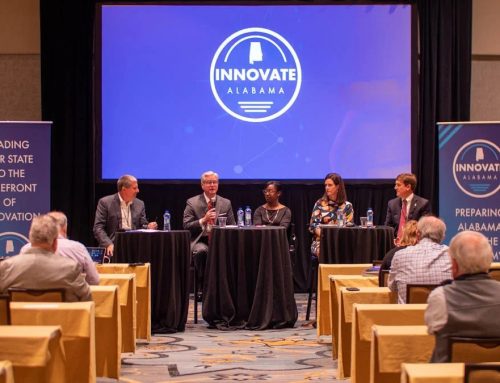The Alabama STEM Ecosystem is joining the STEM Learning Ecosystems Community of Practice (SLECoP) as one of nine new ecosystems devoted to advancing STEM learning opportunities for all.
Through the program, a Montgomery Chamber initiative is in the design process of the I-85 STEM Learning Ecosystem to become part of the statewide STEM Ecosystem and the SLECoP. If selected, TechMGM will stand as one of the first STEM Ecosystems across Alabama.
“We were excited to learn that the state of Alabama had been selected to join the STEM Learning Ecosystems Community of Practice and are hopeful to have TechMGM selected as part of this great initiative through the I-85 STEM Learning Ecosystem,” said Charisse Stokes, executive director of TechMGM. “Our overarching purpose in designing a STEM Ecosystem is to coordinate the work of educators, business/industry partners, non-profits, and government agencies to improve STEM education, enhance career awareness, and enrich talent pipelines across the I-85 corridor.
“This regional ecosystem will span from Montgomery to Tuskegee and on to Auburn.”
The Alabama STEM Ecosystem, which cultivates and strengthens STEM learning and the STEM workforce pipeline for all Alabamians, is now part of a collective at the forefront of improving opportunity in education and workforce alignment. It is anchored by the Alabama STEM Council, formed by Gov. Kay Ivey in 2020 and spearheaded by Dr. Lee Meadows, executive director of The Alabama STEM Ecosystem.
“The addition of the Alabama STEM Ecosystem to the SLECoP is a tremendous achievement that will surely benefit the current and prospective STEM leaders of Alabama,” said Rene McNeal, Alabama’s STEM Ecosystem coordinator. “We are thrilled to continue improving STEM education and workforce development in collaboration with an esteemed group of professionals from across the globe.”
“We are thrilled to welcome the Alabama STEM Ecosystem and the other 10 new Ecosystems, with their unique talents, lived experiences and resources to our Community of Practice,” said Judd Pittman, Chairman of the SLECoP’s Leadership Coordinating Council. “We know that they will learn from and grow with the existing communities expanding opportunities for more diverse scholars to realize the promise of a STEM career.”
Alabama is home to five military bases and 60 colleges and universities, including 38 schools with tech programs offered at 46 locations. Among Alabama’s network of postsecondary institutions are 14 Historically Black Colleges and Universities that deserve heightened attention.
Alabama has numerous STEM education initiatives that are currently beyond the reach of many Alabamians. Implementing a thriving STEM ecosystem will interlace STEM stakeholders into a coordinated network, provide upward economic mobility for more Alabamians, and strengthen the state’s base for innovation, competitiveness, and a knowledge-driven economy of tomorrow.
“Given the unique industries currently emerging in the state – particularly tech, software development and cybersecurity – we have a tremendous opportunity to build a robust STEM workforce while closing demographic gaps and providing economic mobility opportunities for all,” said Charisse Stokes, executive director of TechMGM.






Leave A Comment